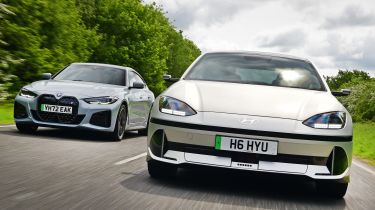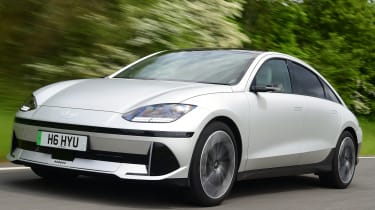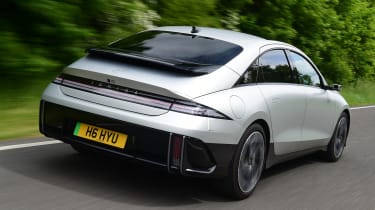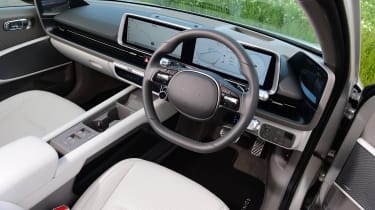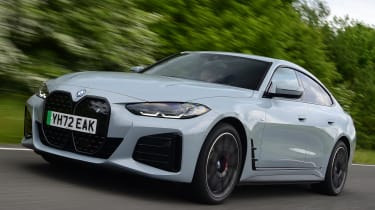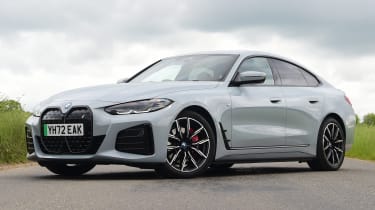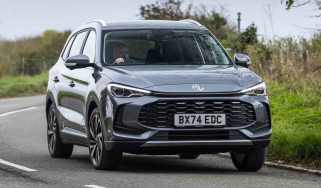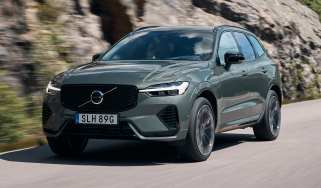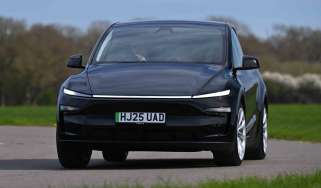Hyundai Ioniq 6 vs BMW i4: 2023 twin test review
Hyundai’s slick new Ioniq 6 takes on the BMW i4 in a fight for electric executive honours
When Hyundai launched the Ioniq 5, it set the company on a trajectory as a maker of premium EVs with a focus on design and technology. It was so good that we named it our 2021 Car Of the Year, and now Hyundai is looking to repeat its success with the new Ioniq 6.
The 6 uses the same electric running gear as the 5, but it comes with a slippery four-door body and a price that positions it as an executive model. That puts it in direct competition with our current favourite premium EV, the BMW i4. So what better way to see how the Ioniq 6 performs than to pitch it against its German rival in our Real-World Road Test?
| Hyundai Ioniq 6 Ultimate | BMW i4 eDrive40 M Sport | |
| Price: | £54,040 | £59,390 |
| Powertrain: | 2x e-motors/77.4kWh lithium-ion battery, 321bhp | 1x e-motor/83.9kWh lithium-ion battery, 335bhp |
| 0-62mph: | 5.1 seconds | 5.6 seconds |
| Test efficiency: | 3.2 miles / kWh | 3.3 miles / kWh |
| Range: | 322 miles | 337 miles |
| Annual VED: | £0 | £0 |
Hyundai Ioniq 6
The Ioniq 6 joins the electric executive sector, which is a part of the market where Hyundai hasn’t made much of an impact in the past. However, the company’s premium EV aspirations mean it believes that it can now make inroads into the class. Prices are slightly higher than they are for the Ioniq 5, starting from £47,040, while we’re testing the top-spec Ultimate model with twin electric motors here, which costs £54,040.
Tech highlights
The chief talking point of the Ioniq 6 is its streamlined shape. It was previewed by the Prophecy concept in 2020, but while some of that car’s more radical design cues didn’t quite make production, the long, lozenge-shaped body is sure to turn heads. The smooth nose, tapering window line and drooping rear end mean it looks nothing like the Ioniq 5 with which it shares so much of its running gear, and a drag coefficient of 0.21Cd means it’s one of the most aerodynamic cars on sale today.
Used - available now

2022 BMW
3 Series Touring
90,170 milesAutomaticPetrol2.0L
Cash £15,895
2022 Volvo
XC40
103,970 milesAutomaticPetrol1.5L
Cash £14,495
2021 Vauxhall
Corsa
29,250 milesManualPetrol1.2L
Cash £8,695
2021 Volkswagen
T-Cross
34,158 milesManualPetrol1.0L
Cash £14,200While the Ioniq 6’s overall shape is in contrast to the 5’s oversized hatchback looks, some of the design details are familiar. The LED light bar across the tail features a similar ‘pixel-block’ appearance, as do the daytime running lights that are set into the lower edge of the headlamp units.
Under the skin is Hyundai’s E-GMP platform, which is also used by the Genesis GV60 and Kia EV6, and rear or four-wheel drive powertrain options are offered. All models come with a 77.4kWh battery, which is slightly smaller than the i4’s 83.9kWh pack.
Safety: There’s a five-star Euro NCAP safety rating for the Ioniq 6, and although that matches the BMW i4 (both were tested in 2022), the Hyundai has higher percentage scores for adult occupant protection and safety-assist systems.
On the road
That low-slung body might give the impression that the Ioniq 6 will be sporty to drive, but comfort is the car’s main focus.
Around town: While the Ioniq 6’s body is set low, the driving position is relatively high, which gives you a good view of your surroundings. Light steering helps with low-speed manoeuvres, while there’s virtually no noise from the powertrain.
There’s a slightly unsettled nature to the suspension, but that is largely a byproduct of the 20-inch wheels that are fitted as standard to every model in the range. Overall, though, the ride is reasonable at low speeds.
A & B-roads: Increase your pace, and the firmness of the suspension can still be felt, although there’s no trade off in terms of engaging handling. Grip is plentiful, but the steering is light and shot of feedback, while the weight of the battery causes the car to roll in corners. The firm damping unsettles the Hyundai if you’re pressing on over bumpy surfaces.
It’s best to take things easy instead and enjoy the comfort that the Ioniq 6 has to offer. Wind and road noise are both kept to a minimum, while the multi-stage regenerative braking allows you to adjust the amount of resistance in the system when lifting off, to the point where one-pedal driving is possible.
Motorway: The Hyundai’s 321bhp powertrain isn’t as powerful as the BMW’s 335bhp system, but there’s more torque on offer. A maximum of 605Nm is 175Nm ahead of the i4, and a 0-62mph time of 5.1 seconds shows the Ioniq 6’s potential. Once up to speed, motorway cruising is relaxing, although that firm edge to the ride still remains.
Ownership
While the Ioniq 5 has a futuristic-looking cabin, the Ioniq 6 is a bit more restrained. It doesn’t feature the Ioniq 5’s open floor space up front; instead it’s fitted with a high centre console that splits the cabin in two. More black plastics are used, although the Ioniq 5’s switchgear, including the rotary drive selector on the steering column and the unbranded wheel itself, have been carried over.
Build quality is excellent, but as with the Ioniq 5, there are a lot of light-coloured materials, and some of the plastics don’t have the same upmarket feel found in the BMW. It’s not obvious that they’re of a poorer quality, they just have different textures.
The Ioniq 6’s slippery shape is meant to boost efficiency, but while the car’s official range figures are around 25 miles greater than those for the Ioniq 5, it returned similar efficiency to the BMW during our test. Our test route included a large number of motorway and A-road miles, but keep to lower speeds around town, and the Ioniq 6 should be able to match the official range claims.
Safety kit on board is identical to the Ioniq 5, so you get plenty of electronic assistance tech. Lane-keep and lane-follow systems work in conjunction with blind-spot detection to keep you safe on the motorway, while front-collision avoidance with pedestrian and cyclist detection is useful around town. Rear cross-traffic alert is another highlight, while remote parking assist allows you to extract the car from a bay while standing outside it.
Practicality
There are sacrifices to be made for the Ioniq 6’s swoopy bodywork.
Storage: Since the Ioniq 6 was designed as an EV from the outset, it should offer clever packaging. The glovebox is a slide-out drawer that’s deeper than the conventional compartment in the BMW, while the centre console has some decent storage, too. But the front and rear door bins are quite narrow, while the wireless phone charging pad at the front of the centre console is set high up, so a device can fall off too easily.
Rear space: The Ioniq 6’s curving roofline compromises headroom in the back a little, but overall there’s more space here than you’ll find in the i4. Taller occupants are likely to find their heads brushing the headlining in the back, but shoulder space is fine and the flat floor creates plenty of foot space for three occupants. Air vents and USBs in the back add convenience.
Boot: The biggest compromises for the Ioniq 6 are reserved for the load area. Since the car is a saloon, the boot opening is narrow, while a higher lip and wider threshold mean it’s trickier to load than the BMW. The back seats have a 60:40 split, but they can only be operated by levers in the boot, not from the cabin, and you’re left with a narrow opening here, too.
What to buy?
Which configuration we’d choose
- Powertrains: Hyundai offers two power outputs in the Ioniq 6, a 224bhp single-motor version driving the rear wheels, or the 321bhp four-wheel-drive model tested here.
- Trim: A First Edition model was available at launch, but the regular line-up comprises Premium and Ultimate specifications. Both are generously equipped for the money.
- Options: There are different paints, including matt hues, while the Ultimate model can be had with the digital side mirrors for £995 extra, but that’s it.
- Our choice: The rear-drive model can go furthest, while Premium trim has enough kit.
BMW i4
The BMW i4 was crowned Premium Electric Car of the Year at the Auto Express New Car Awards, so it’s a pretty strong competitor for the Ioniq 6. Prices start from £49,995, which is around £3,000 more than for the Hyundai, while the eDrive40 M Sport is around £5,000 more than the top-spec Ioniq 6, at £59,390. The options fitted to our test car bump the price even further, to £67,240.
Tech highlights
While the Ioniq 6 is based on a dedicated electric car platform, the i4’s CLAR underpinnings are used also by a variety of combustion-engined models, such as the 3 Series and 4 Series. There’s a five-door Gran Coupé as part of the latter line-up, and this forms the basis for the i4.
As a result, the i4 looks reassuringly familiar when compared with the Ioniq 6. The only clues to its electric powertrain are the blanked-off grille up front and metallic blue detailing dotted around the exterior. Otherwise it could just as easily pass for a 4 Series Gran Coupé.
Under the skin, there’s MacPherson strut front suspension and a multi-link set-up at the rear, while air suspension is fitted to the rear axle as standard. This is designed to help control the extra weight that the i4 has to carry, courtesy of its 83.9kWh battery. Drive is sent to the rear wheels, while BMW has laid the powertrain out so that the i4 has near-50:50 weight distribution, and can deliver the kind of handling that the company’s cars are renowned for.
Safety: Both cars were tested in 2022, so their five- star Euro NCAP ratings can be directly compared, but the BMW’s scores are only ahead of the Hyundai’s in pedestrian safety. One difference between these two is that the i4 doesn’t bombard you with as many warning beeps as the Ioniq 6 in everyday driving.
On the road
As well as familiar BMW looks, the i4’s performance and handling do justice to the German marque, despite the car’s extra weight.
Around town: Responsive controls are great when you want to enjoy a drive, but they also improve a car’s everyday usability, and the BMW i4’s steering, throttle and brakes all work with reassuring positivity. At low speeds (less than 20mph), IconicSounds audio created by Hollywood composer Hans Zimmer is piped externally to warn that the car is moving, and is one of the few areas where the i4 seems more futuristic than the Ioniq 6.
A & B-roads: Where the BMW has the biggest advantage over its rival is in corners. Although the extra weight of the drive battery adds around 500kg to the car when compared with a combustion-engined 4 Series Gran Coupé, the i4 still delivers a responsive and engaging drive.
Our car featured the optional £2,500 M Sport Pro Pack, which adds adaptive suspension, but even in its Comfort setting, the i4 felt more focused and stable than the Hyundai, while Sport mode boosted its agility. The extra weight of the battery is noticeable in corners and under braking, but the i4 is stable and doesn’t roll as much as the Ioniq 6. A 0-62mph time of 5.6 seconds is slower than the Hyundai’s, but the i4 doesn’t feel like a slouch, while the steering offers equally sharp responses.
Motorway: Optional adaptive dampers that are part of the M Sport Pro Pack certainly help the i4 to deliver greater comfort than the Ioniq 6 at motorway speeds, but the M Sport model has smaller wheels that make a contribution, too. Wind and road noise are also kept to a minimum, so the i4 is a relaxing long-distance cruiser.
Ownership
From behind the wheel, the BMW i4 will feel very familiar to anybody who has driven a current 3 Series or 4 Series. That familiarity should help buyers ease their way into the world of electric drive, while an official range of 337 miles will help allay any concerns about range anxiety for all but the longest of journeys.
On test, we couldn’t match the official quotes of either car, but our route involved a large amount of motorway driving, which will always have an impact on an EV’s overall range. Both cars were closely matched for efficiency, though, with the BMW slightly ahead of the Hyundai, returning a figure of 3.3 miles per kWh, compared with 3.2 mi/kWh for the Ioniq 6.
Company car users will be attracted by the Benefit-in-Kind costs for these two cars. And thanks to its lower list price, the Ioniq 6 is slightly ahead. Respective annual costs of £432 and £452 for higher-rate earners won’t break the bank, although bear in mind that adding options to the BMW will see that margin increase.
Charging: Both cars have high-voltage charging capability, with Hyundai quoting a faster rate than BMW. From a 220kW source, the Ioniq 6 can go from 10-80 per cent capacity in just under 20 minutes. The BMW tops up by the same amount in just over half an hour from a 205kW source, but then its battery is 4kWh larger than the Hyundai’s.
Home charging will take longer, and even from a more powerful 11kW industrial source, a full charge is an overnight job. BMW has joined forces with Pod Point to offer domestic chargepoint installations, but Hyundai doesn’t offer any recommendations, aside from using Ionity public chargers. BMW provides two charging cables with the i4, including a Type 2 version that can be used in emergencies with a domestic three-pin socket, but Hyundai just supplies a standard seven-pin Type 3 cable.
Practicality
There’s not as much passenger space as in the Ioniq 6, but the i4 makes up for this with a more practical hatchback boot.
Storage: The door bins are larger than in the Ioniq 6, with enough space for drinks bottles to be held securely. There are phone storage and charging sockets ahead of the gearlever, while the armrest cubby is deep, too
Rear space: While the Ioniq 6 is a genuine five-seater, the i4 has more of a 4+1 layout. The rear bench is narrow, and the outer chairs are more heavily sculpted, leaving a perch in the middle without as much legroom. Back-seat passengers also sit lower, but headroom is fine and a decent glass area means that they don’t feel hemmed in.
Boot: Both cars feature powered tailgates, but the i4 has a hatchback opening and a lower load lip. There’s more space on offer, too, with its 470-litre capacity offering 69 litres more than the Ioniq 6’s boot. The seat backs split 40:20:40 to boost versatility even further, and there’s 1,290 litres of capacity available when running in two-seat mode.
What to buy?
Which configuration we’d choose
- Powertrains: There are three options with the i4: a 282bhp eDrive35 with a 70.2kWh battery, the 335bhp eDrive40 tested here – both of these are rear-wheel drive – or the high-performance M50 with four-wheel drive, 537bhp and the same 83.9kWh battery as the eDrive40.
- Trims: Sport and M Sport specs are available, although only the former can be had with the eDrive35 powertrain. The M50 is a model in its own right.
- Options: In contrast to the Hyundai, BMW offers customers a wide range of personalisation options and packs.
- Our choice: The eDrive40 M Sport tested here offers a long range and decent kit.
Results
Which car comes out on top?
Winner: BMW i4
The BMW i4 remains our first choice in the electric executive sector. It combines zero-emissions running with the kind of engaging driving experience that BMW is famous for, as well as the user-friendly tech that has been a trademark in recent years.
It’s not the roomiest model if you’re travelling with a full complement of passengers, but there’s a useful boot on offer, while the car’s long range and refined driving manners when taking things easy mean it’s a better all-round package than the Ioniq 6.
| Pros | Cons |
| Engaging to drive | Cramped back seats |
| Cruising comfort | Pricey options |
| Practical boot | Insurance costs |
| Long range | Longer charge times |
Runner-Up: Hyundai Ioniq 6
Some buyers will be won over by the Ioniq 6’s swoopy styling alone, but you don’t have to delve much deeper to find that there is substance to go with it. The battery tech offers a long range, and the cabin is comfortable and roomy for the most part, while the long list of standard kit – even on the base model – is attractive.
The ride on those 20-inch wheels is a little on the firm side, but it’s unlikely to be a deal breaker, although the tight saloon-style boot might be another matter.
| Pros | Cons |
| Head-turning looks | Small boot |
| Great on-board tech | Firm edge to the ride |
| Spacious interior | Tight rear headroom |
| Long list of standard kit | Ioniq 5 offers more for less |
Rivals and other options
The BMW i4 wins our twin test, but what else is out there?
Same class: Polestar 2
Same Money: Tesla Model Y
Used: BMW 545e xDrive
Used: Mercedes EQE
Coming soon: BYD Seal
The great debate
What the Auto Express test team would do…
Sean Carson, associate editor: “Even a decade ago, it would’ve been unheard of for Hyundai to take on BMW in a straight fight. So the fact that the Ioniq 6 is able to challenge the i4 on equal terms and come close to beating it is credit to Hyundai’s efforts. I don’t think we’ll need to wait another decade for a win.”
John Mcllroy, deputy editor: “If you’re looking at the entry-level versions of these cars, then the Ioniq 6 could be more tempting than the i4. They both start at less than £50k, but the Hyundai comes with the same 77.4kWh battery as the car tested here, while the BMW features a smaller 70.2kWh battery for a 304-mile range.”
Dawn Grant, picture editor: “It’s great that Hyundai has taken the plunge with building an electric model with head-turning looks, but that’s something that’s also achieved by the Ioniq 5. It offers more room at a lower price, too, and while its range is shorter than the Ioniq 6’s, that’s not going to be a deal-breaker for many.”
Steve Fowler, editor-in-chief: “I really hope that the Ioniq 6 is the start of a new trend for aerodynamically efficient EVs. We’ve seen enough electric SUVs, and concepts such as the Hyundai Prophecy and Mercedes Vision EQXX have shown what’s possible as car makers try to squeeze every last mile of range out of a battery.”
Alex Ingram, chief reviewer: “There’s no high-performance flagship model in the Ioniq 6 range to match the BMW i4 M50, but Hyundai has shown the RN22e concept as a potential range topper. It uses the same 569bhp powertrain as the Kia EV6, as well as gaining a wild bodykit and pale blue ‘N’ paint.”
Which would you buy? Let us know in the comments section below…
Specs and prices
| Hyundai Ioniq 6 Ultimate | BMW i4 eDrive40 M Sport | |
| Petrol, diesel or electric? | Electric | Electric |
| M/kWh | 3.2 | 3.3 |
| Electricity cost (£) | £0.34 | £0.34 |
| P11D value | £53,985 | £56,550 |
| Fill up | £26.32 | £28.53 |
| On the road price/total as tested | £54,040 / £55,920 | £59,390 / £67,240 |
| Residual value (after 3yrs/36,000) | £27,225 / 50.4% | £33,549 / 56.5% |
| Depreciation | £26,815 | £25,841 |
| Annual tax liability std / higher rate | £215.94 / £431.9 | £226 / £452.4 |
| Annual fuel. cost (10k / 20k miles) | £1,063 / £2,125 | £1,030 / £2,061 |
| Ins. group / quote / VED | 37 / £839 / £0 | 36 / £1,375 / £0 |
| Service costs (3 years) | £311 | £540 |
| Length/wheelbase | 4,855 / 2,950mm | 4,785 / 2,856mm |
| Height/width | 1,495 / 1,880mm | 1,448 / 1,852mm |
| Powertrain | 2x electric motors / lithium-ion battery | Single e-motor / lithium-ion battery |
| Peak power | 321bhp | 335bhp |
| Peak torque | 605Nm | 430Nm |
| Transmission | Single-speed auto / rwd | Single-speed / rwd |
| Battery capacity / usable | 77.4 / 77.4 kWh | 83.9 / 81.1 kWh |
| Boot capacity (seats up / down) | 401 / N/A litres *plus 14.5 litre frunk | 470 / 1,290 litres |
| Kerbweight / payload / towing weight | 2,096 / 1,500kg | 2,125 / 1,600kg |
| Turning circle / Drag coefficient | 11.8 metres / 0.21cd | 12.0 metres / 0.24Cd |
| Basic warranty / recovery | 5 yrs (unlimited) / 2 yrs | 3 yrs (unlimited) / 3 yrs |
| Driver Power manufacturer position | 17th | 21st |
| Euro NCAP: Adult / child / ped. / assist / stars | 97 / 87 / 66 / 90 / 5 (2022) | 87 / 87 / 71 / 64 / 4 (2022) |
| 0-62mph / top speed | 5.1 secs / 115mph | 5.6 secs / 118mph |
| Claimed range (WLTP) | 322 miles | 337 miles |
| Charging capability | 11 / 220kW | 11 / 205kW |
| Charging time | 7hrs 10mins / 18mins 10-80% | 8h 15mins / 31mins 10-80% |
| Actual/claimed CO2/tax bracket | 0g/km/ 2% | 0g/km/ 2% |
| Number of airbags / Isofix points | Six / two | Eight / two |
| Parking sensors/camera | F&r / 360 | F&r / yes |
| Lane-keep assist / blindspot / AEB | Yes / yes / yes | Yes / yes / yes |
| Climate control/adaptive cruise ctrl | Yes / yes | Yes / yes |
| Leather/heated seats | Yes / f&r | Yes / f&r |
| Metallic paint / LED lights | £665 / yes | £695 / yes |
| Keyless entry & go/powered tailgate | Yes / yes | Yes / no |
| Sat-nav/digital dashboard/USBs | Yes / yes / five | Yes / yes / four |
| Online services/wireless charging | Yes / yes | Yes / yes |
| Apple CarPlay/Android Auto | Yes / yes | Yes / yes |

